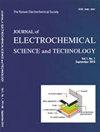提高无阳极电池电化学性能的LiPF6-LiFSI混合盐电解质体系
IF 3
4区 工程技术
Q3 ELECTROCHEMISTRY
Journal of electrochemical science and technology
Pub Date : 2021-08-13
DOI:10.33961/jecst.2021.00535
引用次数: 8
摘要
使用正极材料锂操作的无阳极锂金属电池(AFLMBs)由于其源自受限电池体积中的无阳极结构的异常能量密度而引起了极大的关注。然而,锂在铜集电器上不受控制的树枝状生长可能会限制其实际应用,因为它会导致稳定循环的致命问题,如死锂的形成、不稳定的固体电解质界面、电解质耗尽和内部短路。为了克服这一限制,我们报道了一种新型的双盐电解质,该电解质包含在碳酸酯/酯共溶剂中的0.2M LiPF6+3.8M双(氟磺酰基)锂酰亚胺与5wt%的氟碳酸亚乙酯、2wt%的碳酸亚乙烯酯和0.2wt%的LiNO3添加剂。由于双盐电解质有助于在集电器上均匀/致密地沉积Li,并且可以在沉积的Li上形成坚固/离子导电的基于LiF的SEI层,因此Li/Li对称电池在超过200小时的操作中表现出改进的循环性能和低极化。此外,与由不同盐比例组成的对应物相比,碳酸盐电解质中的无阳极LiFePO4/Cu电池显示出显著增强的循环稳定性。该研究表明,电解质设计对AFLMBs的均匀Li沉积和形成稳定的SEI层具有重要意义。本文章由计算机程序翻译,如有差异,请以英文原文为准。
A LiPF6-LiFSI Blended-Salt Electrolyte System for Improved Electrochemical Performance of Anode-Free Batteries
ANODE-free Li-metal batteries (AFLMBs) operating with Li of cathode material have attracted enormous attention due to their exceptional energy density originating from anode-free structure in the confined cell volume. However, uncontrolled dendritic growth of lithium on a copper current collector can limit its practical application as it causes fatal issues for stable cycling such as dead Li formation, unstable solid electrolyte interphase, electrolyte exhaustion, and internal short-circuit. To overcome this limitation, here, we report a novel dual-salt electrolyte comprising of 0.2 M LiPF 6 + 3.8 M lithium bis(flu-orosulfonyl)imide in a carbonate/ester co-solvent with 5 wt% fluoroethylene carbonate, 2 wt% vinylene carbonate, and 0.2 wt% LiNO 3 additives. Because the dual-salt electrolyte facilitates uniform/dense Li deposition on the current collector and can form robust/ionic conductive LiF-based SEI layer on the deposited Li, a Li/Li symmetrical cell exhibits improved cycling performance and low polarization for over 200 h operation. Furthermore, the anode-free LiFePO 4 /Cu cells in the carbonate electrolyte shows significantly enhanced cycling stability compared to the counterparts consisting of different salt ratios. This study shows an importance of electrolyte design guiding uniform Li deposition and forming stable SEI layer for AFLMBs.
求助全文
通过发布文献求助,成功后即可免费获取论文全文。
去求助
来源期刊

Journal of electrochemical science and technology
ELECTROCHEMISTRY-
CiteScore
6.30
自引率
8.10%
发文量
44
期刊介绍:
Covering fields:
- Batteries and Energy Storage
- Biological Electrochemistry
- Corrosion Science and Technology
- Electroanalytical Chemistry and Sensor Technology
- Electrocatalysis
- Electrochemical Capacitors & Supercapcitors
- Electrochemical Engineering
- Electrodeposition and Surface Treatment
- Environmental Science and Technology
- Fuel Cells
- Material Electrochemistry
- Molecular Electrochemistry and Organic Electrochemistry
- Physical Electrochemistry
- Solar Energy Conversion and Photoelectrochemistry
 求助内容:
求助内容: 应助结果提醒方式:
应助结果提醒方式:


